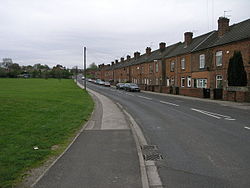Treeton
| Treeton | |
| Yorkshire West Riding | |
|---|---|
 Treeton Terrace | |
| Location | |
| Grid reference: | SK432877 |
| Location: | 53°23’4"N, 1°21’5"W |
| Data | |
| Population: | 3,189 (2011) |
| Post town: | Rotherham |
| Postcode: | S60 |
| Dialling code: | 0114 |
| Local Government | |
| Council: | Rotherham |
| Parliamentary constituency: |
Rother Valley |
| Website: | treetonparishcouncil.gov.uk |
Treeton is a village in the West Riding of Yorkshire, about six miles south of the Rotherham and five miles east of Sheffield city centre.
The village stands on the east side of the River Rother, on the slopes of the Rother Valley. The lower section of the village is susceptible to flooding and had to be evacuated during the floods of June 2007 because of fears that cracks in the dam at Ulley reservoir could lead to widespread flooding in the valley.[1]
The name Treeton is Old English in origin and may mean 'tree farmstead' or 'farmstead built with posts'.[2]
History
Of ancient days, a Neolithic polished stone axe was found at Gregory Hill Field in 1954. and in 1957 Mesolithic flint cores were found in Treeton Wood. There was a Roman fort at Templeborough, about three miles north-west of Treeton, and remnants of the Roman road called Icknield Street (sometimes Ryknild or Riknild Street) have been found in nearby Brinsworth.[3]
The earliest known written record of Treeton is the Domesday Book of 1086, in which it is referred to as Trectone or Tretone. The Domesday Book also mentions that the village had two mills and a church. The present parish church the Church of St Helen was originally built in the 12th century, but may have included parts of an earlier church. The church was expanded in the 14th century and extensively restored in the 19th century.[4]
The North Midland Railway built a railway through the village in 1840, this later became the Midland Railway.[5] a station at Treeton until 1951.
A colliery was built at Treeton starting in 1875, and 400 houses were built between 1881 and 1905 to house miners' families. Treeton Colliery closed in 1990 and the site has since been redeveloped for homes.
About the village
The Church of St. Helen is a Grade I listed building, and the village stocks outside the church are Grade II listed. Other Grade II listed buildings in the village include The Georgian House, formerly the church rectory, and 18th century farm buildings on Station Road and at Spa House Farm.
Catcliffe Flash, to the west of the village, is a local nature reserve that is made up of a lake and marshland formed as the elevation of the land beside the River Rother dropped due to coal mining subsidence.[6] To the south-east of the village are three areas of ancient woodland, Treeton Wood,[7] Hail Mary Hill Wood, and Falconer Wood,[8] which are managed forests.
Outside links
| ("Wikimedia Commons" has material about Treeton) |
- Treeton in the Domesday Book
References
- ↑ "Floods force thousands from homes". BBC News (BBC). 26 June 2007. http://news.bbc.co.uk/1/hi/uk/6239828.stm. Retrieved 16 January 2009.
- ↑ Mills, Anthony David: 'A Dictionary of British Place-Names' (Oxford University Press, 2003) ISBN 978-0-19-852758-9, page Treeton
- ↑ "Roman Britain in 1948: I. Sites Explored". The Journal of Roman Studies (Society for the Promotion of Roman Studies) 39: 96–115. 1949. doi:10.2307/297711.
- ↑ National Heritage List 1132728: Church of St. Helen (Grade I listing)
- ↑ Stretton, Clement Edwin (1901). "The North Midland Railway". The History of the Midland Railway. London: Methuen & Co. pp. 47–61. https://archive.org/details/historymidlandr00stregoog.
- ↑ "Catcliffe Flash LNR". Rotherham Metropolitan Borough Council. http://www.rotherham.gov.uk/graphics/Leisure/Countryside+and+Wildlife/Local+Nature+Reserves/Catcliffe+Flash.htm. Retrieved 16 January 2009.
- ↑ "Treeton Wood". Fuelling a Revolution. South Yorkshire Forest. http://www.heritagewoodsonline.co.uk/map/012/012.html. Retrieved 16 January 2009.
- ↑ "Hail Mary Hill and Falconer Woods". Fuelling a Revolution. South Yorkshire Forest. http://www.heritagewoodsonline.co.uk/map/010/010.html. Retrieved 16 January 2009.
